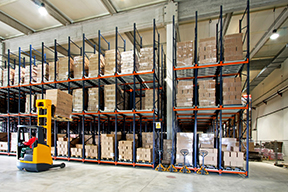9/22/2017
BY: RUSS MASON
Reconsidering your facility’s layout will enable your business to  reduce material handling costs, minimize space requirements, and reduce energy bills. Whether you’re relocating completely or simply re-arranging your current set-up, there are several goals to keep in mind:
reduce material handling costs, minimize space requirements, and reduce energy bills. Whether you’re relocating completely or simply re-arranging your current set-up, there are several goals to keep in mind:
- Improve work flow by becoming more organized
- Eliminate waste
- Maximize effectiveness
- Save time and money
- Reduce risks
To successfully optimize your plant’s layout, both spatial and process-related concepts must be taken into consideration, as well as those ideas that are tied to a human element.
Many plants in modern times follow a plan known as “lean manufacturing” combined with a concept known as “Six Sigma.” The concepts were developed in the late 1980s and early 90s and aim to enhance the successes of any manufacturer. Here are some general rules created by these combined concepts that will help optimize your manufacturing layout:
- Optimize the macro-flow of the entire facility first, allowing you to avoid sub-optimization within narrow departments or functional areas.
- Create spatial relationships while keeping a linear flow in the back of your mind. The influx of raw materials should flow seamlessly with the outflux of goods. By maximizing this efficiency, you also will reduce waste!
- Design for the lateral receipt, inspection, prep and just-in-time (JIT) insertion of auxiliary materials.
- Integrate supervisory staff offices and support functions with the production.
- Simplify, combine and automate the sequence of operations to reduce variation, shorten cycle times and minimize handling of materials, repetitive motion issues and employee fatigue.
- Optimize the environment to create easily cleaned, well-lit work areas utilizing daylight where possible, adding color where appropriate and using ventilation systems to keep dust, dirt and other contaminants away from workers and finished products.
These steps take several important concerns into account: guaranteeing a high quality of goods, securing the safety and well-being of your workers, and allowing for the most effective production schedule possible.
The combination of these concepts proves successful because they take the entire plant into consideration when it comes to creating the best design. It allows for all moving parts to flow seamlessly ensuring an efficient use of equipment, material, people and energy.
MEET OUR EXPERT
Russ Mason, Lean Program Manager
Russell Mason is a Lean Program Manager for the Business Solutions Team. His areas of expertise include change leadership and management development, sales and operations planning, management operating systems, supply chain effectiveness, and a range of continuous improvement approaches focusing on lean and agile methodologies such as finite capacity scheduling, demand pull systems, and related management processes that optimize operational throughput. To read Russ' full bio, visit
the-center.org.
Since 1991, the Michigan Manufacturing Technology Center has assisted Michigan’s small and medium-sized businesses to successfully compete and grow. Through personalized services designed to meet the needs of clients, we develop more effective business leaders, drive product and process innovation, promote company-wide operational excellence and foster creative strategies for business growth and greater profitability. Find us at www.the-center.org.
Categories: Lean Principles,
Six Sigma